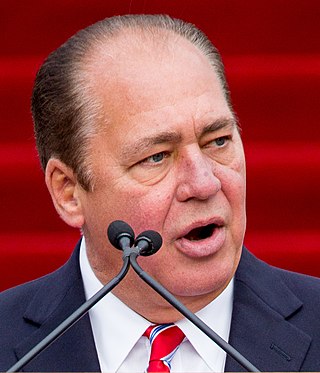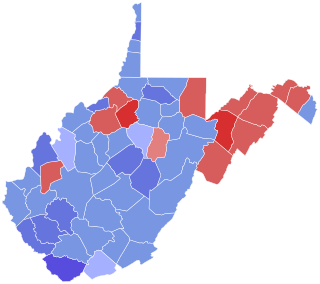Related Research Articles

The vice president of the United States (VPOTUS) is the second-highest officer in the executive branch of the U.S. federal government, after the president of the United States, and ranks first in the presidential line of succession. The vice president is also an officer in the legislative branch, as the president of the Senate. In this capacity, the vice president is empowered to preside over the United States Senate, but may not vote except to cast a tie-breaking vote. The vice president is indirectly elected at the same time as the president to a four-year term of office by the people of the United States through the Electoral College, but the electoral votes are cast separately for these two offices. Following the passage in 1967 of the Twenty-fifth Amendment to the US Constitution, a vacancy in the office of vice president may be filled by presidential nomination and confirmation by a majority vote in both houses of Congress.

The United States presidential line of succession is the order in which the vice president of the United States and other officers of the United States federal government assume the powers and duties of the U.S. presidency upon an elected president's death, resignation, removal from office, or incapacity.
An acting president of the United States is a person who exercises the powers and duties of the president of the United States despite not holding the office in their own right. There is an established presidential line of succession in which officials of the United States federal government may be called upon to be acting president if the incumbent president becomes incapacitated, dies, resigns, is removed from office during their four-year term of office; or if a president-elect has not been chosen before Inauguration Day or has failed to qualify by that date.

The Virginia General Assembly is the legislative body of the Commonwealth of Virginia, the oldest continuous law-making body in the Western Hemisphere, and the first elected legislative assembly in the New World. It was established on July 30, 1619.

The Senate of Virginia is the upper house of the Virginia General Assembly. The Senate is composed of 40 senators representing an equal number of single-member constituent districts. The Senate is presided over by the lieutenant governor of Virginia. Prior to the American War of Independence, the upper house of the General Assembly was represented by the Virginia Governor's Council, consisting of up to 12 executive counselors appointed by the colonial royal governor as advisers and jurists.

The lieutenant governor of the Commonwealth of Virginia is a constitutional officer of the Commonwealth of Virginia. The lieutenant governor is elected every four years along with the governor and attorney general.

The West Virginia Legislature is the state legislature of the U.S. state of West Virginia. A bicameral legislative body, the legislature is split between the upper Senate and the lower House of Delegates. It was established under Article VI of the West Virginia Constitution following the state's split from Virginia during the American Civil War in 1863. As with its neighbor and former constituent Virginia General Assembly, the legislature's lower house is also referred to as a "House of Delegates."

The West Virginia Senate is the upper house of the West Virginia Legislature. There are seventeen senatorial districts. Each district has two senators who serve staggered four-year terms. Although the Democratic Party held a supermajority in the Senate as recently as 2015, Republicans now dominate in the chamber, and hold 31 seats to the Democrats' three seats.

Earl Ray Tomblin is an American politician who served as the 35th governor of West Virginia from 2011 to 2017. A member of the Democratic Party, he previously served in the West Virginia Senate from 1980 to 2011 and as president of the West Virginia Senate from 1995 to 2011. Tomblin became acting governor in November 2010 following Joe Manchin's election to the U.S. Senate. He won a special election in October 2011 to fill the unexpired term ending on January 14, 2013, and was elected to a full term as governor in November 2012.

The Louisiana State Senate is the Upper House of the State Legislature of Louisiana. All senators serve four-year terms and are assigned to multiple committees.

The president of the West Virginia Senate is a member of the West Virginia Senate who has been elected to be its president by the other senators. The current Senate president is Craig Blair, who has been in office since January 2021.

The drafting of the Constitution of the United States began on May 25, 1787, when the Constitutional Convention met for the first time with a quorum at the Pennsylvania State House in Philadelphia, Pennsylvania to revise the Articles of Confederation. It ended on September 17, 1787, the day the Frame of Government drafted by the convention's delegates to replace the Articles was adopted and signed. The ratification process for the Constitution began that day, and ended when the final state, Rhode Island, ratified it on May 29, 1790.
The government of Virginia combines the executive, legislative and judicial branches of authority in the Commonwealth of Virginia. The current governor of Virginia is Glenn Youngkin. The State Capitol building in Richmond was designed by Thomas Jefferson, and the cornerstone was laid by Governor Patrick Henry in 1785. Virginia currently functions under the 1971 Constitution of Virginia. It is Virginia's seventh constitution. Under the Constitution, the government is composed of three branches: the legislative, the executive and the judicial.
In the United States, state governments are institutional units exercising functions of government at a level below that of the federal government. Each U.S. state's government holds legislative, executive, and judicial authority over a defined geographic territory. The United States comprises 50 states: 9 of the Thirteen Colonies that were already part of the United States at the time the Constitution took effect in 1789, 4 that ratified the Constitution after its commencement, plus 37 that have been admitted since by Congress as authorized under Article IV, Section 3 of the Constitution.

A lieutenant governor is an official in state governments of 45 out of 50 of the United States. In most cases, the lieutenant governor is the highest officer of state after the governor, standing in for that officer when they are absent from the state or temporarily incapacitated. In the event a governor dies, resigns or is removed from office, the lieutenant governor typically becomes governor.

The United States Senate is the upper chamber of the United States Congress. The United States Senate and the lower chamber of Congress, the United States House of Representatives, comprise the federal bicameral legislature of the United States. Together, the Senate and the House have the authority under Article One of the U.S. Constitution to pass or defeat federal legislation. The Senate has exclusive power to confirm U.S. presidential appointments to high offices, approve or reject treaties, and try cases of impeachment brought by the House. The Senate and the House provide a check and balance on the powers of the executive and judicial branches of government.

The 2010 United States Senate special election in West Virginia was held on November 2, 2010. Incumbent Democratic Senator Robert Byrd died in office on June 28, 2010. Democratic Governor Joe Manchin appointed Carte Goodwin to temporarily fill the vacancy. Goodwin pledged to not run for election to the seat in exchange for the appointment. This was the first open U.S. Senate seat in West Virginia since 1984 and the first in this seat since 1956. Manchin won the open seat and served out the remainder of Byrd's elected term, which ended on January 3, 2013.

The United States elections of 1788–1789 were the first federal elections in the United States following the ratification of the United States Constitution in 1788. In the elections, George Washington was elected as the first president and the members of the 1st United States Congress were selected.

The 1984 Virginia State Elections took place on Election Day, November 6, 1984, the same day as the U.S. Presidential, U.S. Senate, and U.S. House elections in the state. The only statewide elections on the ballot were two constitutional referendums to amend the Virginia State Constitution. Because Virginia state elections are held on off-years, no statewide officers or state legislative elections were held. All referendums were referred to the voters by the Virginia General Assembly.
References
- ↑ "Constitution of Virginia". Division of Legislative Automated Systems. Retrieved 19 March 2015.